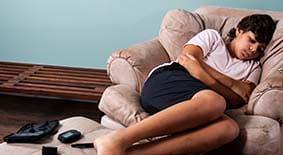Monitoring Your Child's Blood Glucose Levels
Regularly checking your child’s blood glucose is a key part of managing their diabetes appropriately. The goal is to keep blood glucose, or blood sugar levels, within a target range that their doctor considers safe and healthy for their body. Although blood glucose checks can be stressful at first, with time, a little guidance and the right tools, eventually this part of diabetes can become just another part of your child’s daily routine.
Your child’s blood glucose levels are not always the same, and will not remain in their target range at all times. There are many natural factors that can affect blood glucose levels, and you will learn what changes to make to your child’s treatment plan to adjust for these normal fluctuations.

“Not every child with diabetes will have the same target blood glucose range,” explains Andrew Muir, MD, Medical Director of Endocrinology and Diabetes at Children’s. However, as a general rule, the American Diabetes Association (ADA) suggests that target blood sugar levels for all children and adolescents with type 1 diabetes should be:
- Before meals (mg/dl): 90 to 130
- Before bed (mg/dl): 90 to 150
What factors cause high blood glucose levels?
- Food: Certain foods called carbohydrates (or carbs) can raise your child’s blood glucose.
- Hormones: As your child grows and develops, insulin needs often increase. This is due to chemicals in the body called hormones.
- Hormones can make your child’s body less sensitive to insulin.
- Insulin needs will increase when hormone levels are high, like during the teen years.
- Stress: The body makes stress hormones that can increase your child’s blood glucose level the same way that growth hormones do.
- Illness: Illness can increase blood glucose and make insulin less effective, putting your child at risk for ketones.
What factors lower blood sugar levels?
- Exercise: Your child’s activity level likely changes throughout the year. They may play a sport in the spring and fall, but not during the winter. This affects how much energy they burn and changes how much insulin they need.
- When your child is more active, they usually need less insulin.
- When your child is less active, they usually need more insulin.
- Insulin and diabetes medicines: Insulin and other diabetes medicines lower blood glucose.
Your child’s diabetes team will train you on how to use a blood glucose monitor. Keep in mind that if your child attends school, they will need two meters—one for home and one for school.
How do you check your child's blood glucose?
Using a blood glucose meter involves collecting a drop of blood from your child’s finger. Here are some tips to ensure you get an accurate test result and don’t have to repeat the process.
- Wash hands with warm soap and water and dry thoroughly.
- Dry your child’s hands well; damp hands can affect a blood sugar reading.
- Avoid using rubbing alcohol to clean your child’s fingers. It can dry out the skin on their fingertips.
- To help increase the blood flow to the fingers and make it easier to get a drop of blood:
- Warm your child’s hands by rubbing them together.
- Hang your child’s hand down at their side for 1 to 2 minutes.
- Put test strip into the meter.
- Collect a small blood sample.
- Prick the side of their finger and apply pressure to form a drop of blood.
- Wait for finger prompt on meter and then engage the needle to take blood.
- Touch the edge of the strip to the drop of blood.
- Be sure you get the right amount. Not putting enough blood on a strip can cause an incorrect reading or error code.
- If the meter shows an error code, that means there has been an error and blood should be taken again using another test strip.
- Keep a record of the blood sugar reading and time.
- Check the date and time in your meter to be sure it is correct. This allows you to review your child’s blood sugar readings using the memory function.
- Dispose of needles appropriately.
- Sharps should be placed in a sturdy plastic container that is clearly labeled and out of reach of others.
- Store your meter and strips in a safe place.
- Keep your meter in a clean, dry place and be sure the bottle of test strips is tightly closed and away from heat, steam and light.
In addition to monitoring blood glucose with finger sticks, many people with diabetes elect to utilize continuous glucose monitors (CGM) to monitor glucose levels and trends. A CGM monitors glucose levels throughout the day and night as well as lets you know the direction or trend your glucose is going. Most CGMs have alarms to let you know if the glucose is too high or too low. Blood glucose testing with a meter may still be necessary at times to make sure your CGM is working correctly. There are several types of CGMs available, so talk with your child’s healthcare team to see if your child is a good candidate for a CGM or if it is covered by your child’s insurance.
Glucose levels change during the day and night depending on what your child eats, how much insulin or medicine you have given them, and other factors (such as exercise, stress, illness and growth). By effectively monitoring blood glucose levels and reviewing trends, you will better understand:
- How your child’s body reacts to different activities, foods and other factors.
- How to treat your child, including how much insulin they should take and when.
- How to adjust your child’s insulin or medicine, as well as diet and activity in order to maintain their target blood sugar range.
For the most accurate record of how your child’s blood sugar levels fluctuate throughout the day, you should check blood sugar levels multiple times a day:
- Typically before each meal and before bed (around four or more times per day)
- In the middle of the night when first diagnosed with diabetes or after a high-activity day
- Anytime unusual symptoms (such as nausea, sweating and vomiting) occur
- If your child uses a CGM, a fingerstick should be done any time they may have symptoms that do not match what the CGM reading indicates.
Your child can still have sweet snacks, but you must make adjustments to allow for it. Like all carbohydrates, sugar raises blood glucose levels. When sugar, such as juice or candy, is eaten without any other food, blood glucose rises very quickly. If sugar is eaten with a meal that also contains fat and protein, blood glucose rises slower.
An occasional sweet treat is fine if insulin doses are adjusted to allow for the sugar content and the treat is eaten with a meal. However, most kids should not substitute a high-sugar treat for a complex carbohydrate like bread, pasta or vegetables.
Andrew Muir, MD, is a board certified physician in pediatric endocrinology. Dr. Muir earned his medical degree at the University of Toronto Faculty of Medicine, and completed his residency at the Hospital for Sick Children in Toronto. He then completed a fellowship in pediatric endocrinology at the Washington University School of Medicine in St. Louis, Missouri, and then worked as a clinical research fellow at the University of Florida College of Medicine in Gainesville. Dr. Muir serves as the medical director of the Endocrinology and Diabetes Program at Children’s, and holds an academic appointment as an endocrinology professor at the Emory University School of Medicine. His research aims to understand the causes and effects of diabetes in children, and he has published numerous articles and authored or co-authored book chapters.
This content is general information and is not specific medical advice. Always consult with a doctor or healthcare provider if you have any questions or concerns about the health of a child. In case of an urgent concern or emergency, call 911 or go to the nearest emergency department right away. Some physicians and affiliated healthcare professionals on the Children’s Healthcare of Atlanta team are independent providers and are not our employees.
Contact Us 404-785-KIDS (5437)



